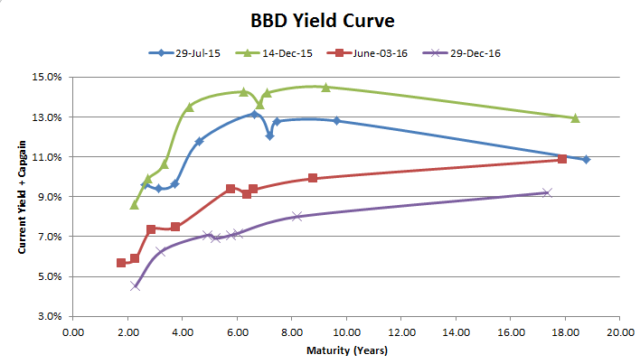AMA (Ask me anything)…
The irreverent (but not irrelevant!) Nelson has linked to me in the past, so I will link to his post on something non-finance related and repeat the theme here.
I’m compiling the year-end (as today was the last trading day in the markets for 2016) and doing some year-end reflections, in addition to some projections of what we will be seeing in 2017.
In the meantime, I invite readers here to “ask me anything” via the comments below, and I will endeavor to answer in a timely fashion.
Happy New Year.
Bombardier credit market completely out of the woods now
Bombardier’s bonds have traded considerably higher since their latest 8.75% bond issue (maturing December 2021) which is now trading at a premium to par.
They have to be looking at this and thinking about securing further long-term funding. It also gives them a lot more negotiating power with the Canadian government, who wants to inject some more money into the corporation (whether they need it or not) for political reasons.
Floating rate preferred shares are yielding 8%, while the fixed rate is yielding 9% (quite the premium to pay for a floating rate). Given the difference between the bond market and the preferred share market, I still believe the preferred shares are trading slightly cheap to what they actually should be.
The equity is also receiving quite a bid as of late, despite the massive warrants overhang in their earlier year government fundings. If they receive another large order for C-Series aircraft (something slightly larger than Air Tanzania), it is quite likely the stock will rise even further.
Details of Genworth Financial merger
There are lots of juicy details of the merger proposal with Genworth Financial in their preliminary proxy filing. In particular there are some hints that Genworth MI in Canada will get sold off whether this merger is successful or not.
Despite all short-sellers and naysayers believing that the Canadian housing market is going to crap, Genworth MI continues to appreciate post-Trump and is still trading 10% below their book value. They’ll continue to be mystified when the stock will break through its all-time highs it reached back in November 2014:
Not coincidentally, that’s when I last sold shares. I will note the price has been adjusted multiple times due to their rather large dividend (currently $1.76/share), and whether the Genworth Financial merger is successful or not, it is quite probable that Genworth MI Canada will be sold for as much as can be sought for it, because doing so before the Canadian housing market collapses is the only smart thing to do.
In terms of valuation, one can make a good claim for over CAD$40/share.
The market is also not appreciating at all the notion that mortgage insurance rates will be headed higher in early 2017 due to capital changes. The last time mortgage insurance rates went higher, the stock went up about 10%.
They are also somewhat buoyed by the “good politics, bad policy” decision by the BC government to extend a 5-year interest-free loan, matching dollar-for-dollar on the first 5% of a downpayment (for an insured mortgage). It would be a poor decision for a prospective buyer in BC to not take advantage of this, but they would need to pay mortgage insurance to do so.
Genworth Financial / Long-Term Care Insurance
For those of you that are interested in why Genworth Financial (NYSE: GNW) is willing to be bought out at US$5.43/share when their book value is far, far higher should take notice of this following Wall Street Journal article about the woes of another long-term care insurance provider that went belly-up.
Putting a long story short, there is an accounting mismatch – the liabilities on the book are less than what the actual liabilities will be.
There has been a lot of incorrect analysis (especially on Seeking Alpha) on the actual value of the holding company. In general when one sees sloppy analysis that is regarded as consensus, there is a necessary, but not sufficient condition for an investment decision in the contrary.

